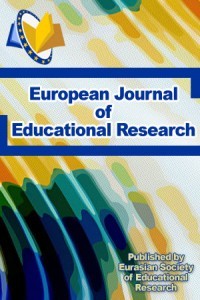Visualizing Music as a Basic Design Assignment in Architectural Education
Visualizing Music as a Basic Design Assignment in Architectural Education
Visual composition, basic design, music architecture, design tool,
___
- Aridag, L., & Aslan, A. E. (2012). Tasarim calismalari-1 studyosunda uygulanan yaratici drama etkinliklerinin mimarlik ogrencilerinin yaratici dusunce becerilerinin gelisimine etkisi [The effect of creative drama activities performed at the design studies-1 studio on development of creative thinking skills of architecture students]. Megaron Journal, 7(1), 49-66.
- Aridag, L., & Kos, F. C. (2015). Mimari tasarim studyosunda dinamik dizge olarak mekanin yeniden uretimi: alternatif plaj [Regeneration of space as a dynamic system in the architectural design studio: alternative beach]. Mimarist Journal, 2015/3, 101-105.
- Besgen, A., Kuloglu, N., & Fathalizadehalemdari, S. (2015). Teaching/learning strategies through art: art and basic design education. Procedia-Social and Behavioral Sciences, 182, 428–432.
- Cuhadar, H. (2008). Muzik ve beyin [Music and Brain]. Journal of Cukurova University Institute of Social Sciences, 17(2), 67–76.
- Dewidar, K. M., Yossef, M. N. A., & Salama, H. A. (2008). Mutual relation role between music and architecture in design development methods. First International Architecture and Urban Planning Conference.Cairo, Egypt.
- Gross, M. D., & Do, E. Y. (1997). The design studio approach: learning design in architecture education. J. Kolodner and M. Guzdial (Ed.) Design education workshop, EduTech/NSF, College of Computing, Georgia Institute of Technology, Atlanta.
- Gurer, L. (1998). Yuksek ogretimde gorsel sanat egitimi [Visual art education in higher education]. N. Teymur & T.A. Dural (Eds.) Temel tasarim / temel egitim [Basic design/basic education] (pp. 29-34). Ankara: ODTU Mimarlik Fakultesi Yayinlari.
- Kuloglu, N. (2015). Teaching strategies learning through art: music and basic design education. Procedia - Social and Behavioral Sciences, 182, 395 – 401.
- Ledewitz, S. (1985). Models of design in studio teaching. Journal of Architectural Education, 38(2), 2-8.
- Leopold, C. (2005). Experiments on relations between geometry, architecture and music. Journal for Geometry and Graphics 9(2), 169–176.
- Lutz, J. (2005). Thinking outside the (Music) box: collaborations between composers and architects. Proceedings of the 93rd ACSA Annual Meeting, The Art of Architecture/The Science of Architecture, 69-74.
- Maze, J. (2001). Jigs, reels, and the occasional air: utilizing irish traditional music in the fundamental design studio. Proceedings of 89th ACSA Annual Meeting, Baltimore, 185-203.
- Maze, J. (2002). Musical beginnings: musings on teaching with music in the fundamental design studio. Proceedings of the 18th National Conference on the Beginning Design Student, Portland, Oregon, 111-119.
- Neiman, B. R. (2006). Bebop spaces: master take. Proceedings of Architecture, Music, Acoustic. International Cross-Disciplinary Conference, Ryerson University, Toronto, Canada.
- Neiman, B. (2007). Bebop spaces: master takes. C. Ripley & M. Polo and A. Wrigglesworth (Eds.) In the place of sound: architecture | music | acoustics (pp. 57-62). Newcastle, UK: Cambridge Scholars Publishing.
- Neiman, B. R. (2009). Bebop constructions: Analog-Digital Design Improvisations. Proceedings of the colloquium Communicating (by) Design, Sint-Lucas Brussels, 333-341.
- Okatan, I. (2012). Muzigin sozel dili [Verbal language of music]. İstanbul: Cinius Yayinlari.
- Onur, D., & Zorlu, T. (2017). Tasarim studyolarinda uygulanan egitim metotlari ve yaraticilik iliskisi [The relation between the training methods applied in design studios and the creativity]. The Turkish Online Journal of Design, Art and Communication, 7(4), 542-555.
- Ozgencil Yildirim, S. (2003). Mimari tasarim surecinin problematikleri [Problematique of architectural design process]. Ege Mimarlik, 47, 35-40.
- Pasin, B. (2008). Sound-object-space: a case study on utilizing musical composition for an interdisciplinary basic design education. Paper presented at 24th National Conference on The Beginning Design Student: We have never been pre-disciplinary, Georgia Institute of Technology, Atlanta, Georgia.
- Pentak, S., & Lauer, D. A. (2014). Design Basics (Ninth Edition). Boston, USA: Cengage Learning.
- Pou, E. S. (2012). Architecture must follow the strategy of music: sharing. Proceedings of 100th ACSA International Conference, Change, Architecture, Education, Practice, Barcelona, 55-56.
- Ripley, C. (2007). Introduction: in the place of sound. C. Ripley, M. Polo & A. Wrigglesworth (Eds.) In the place of sound: architecture | music | acoustics (pp. 1-11). Newcastle, UK: Cambridge Scholars Publishing.
- Rao, R. (2014). Music in architecture too… . Architecture – Time Space and People, 32-35.
- Royalty, A. (2018). Design-based pedagogy: investigating an emerging approach to teaching design to non-designers. Mechanism and Machine Theory, 125, 137-145.
- Sarioglu Erdogdu, G. P. (2016). Temel tasarim egitimi: bir ders plani ornegi [Basic design education: a course outline proposal]. Journal of Planning, 26 (1), 7-19.
- Schillinger, J. (1946). The schillinger system of musical composition. New York: Carl Fischer Inc.
- Soliman, A. M. (2017). Appropriate teaching and learning strategies for the architectural design process in pedagogic design studios. Frontiers of Architectural Research, 6, 204,217.
- Tayyebi, F. (2013). Quest on the relationships between music and architecture (Unpublished Master Thesis). Eastern Mediterranean University Institute of Graduate Studies and Research, North Cyprus.
- Ustun, G. O., & Kalayci, P. D. (2017). Mimarlik-muzik etkilesiminde yontemsel yaklasimlar [Methodological approaches in architecture-music interaction]. International Refereed Journal of Design and Architecture, 10, 16-36.
- ISSN: 2165-8714
- Başlangıç: 2012
- Yayıncı: Eurasian Society of Educational Research
Writing for and Because of Lifelong Learning
A Mixed Research on Cheating and Absenteeism Behaviors of Teacher Certificate Program Students
Orhan KAHYA, Halim SARİCAOGLU, Ali YAKAR
Kadriye KAYACAN, İsil SONMEZ EKTEM
Using Personal and Social Responsibility Model for Gaining Leadership Behavior in Students
Manuela SANCHES-FERREİRA, Silvia ALVES, Monica SİLVEİRA-MAİA, Manuela GOMES, Barbara SANTOS, Pedro LOPES-DOS-SANTOS
Evaluation of Cultural Sensitivity in Healthcare Service among Nursing Students
